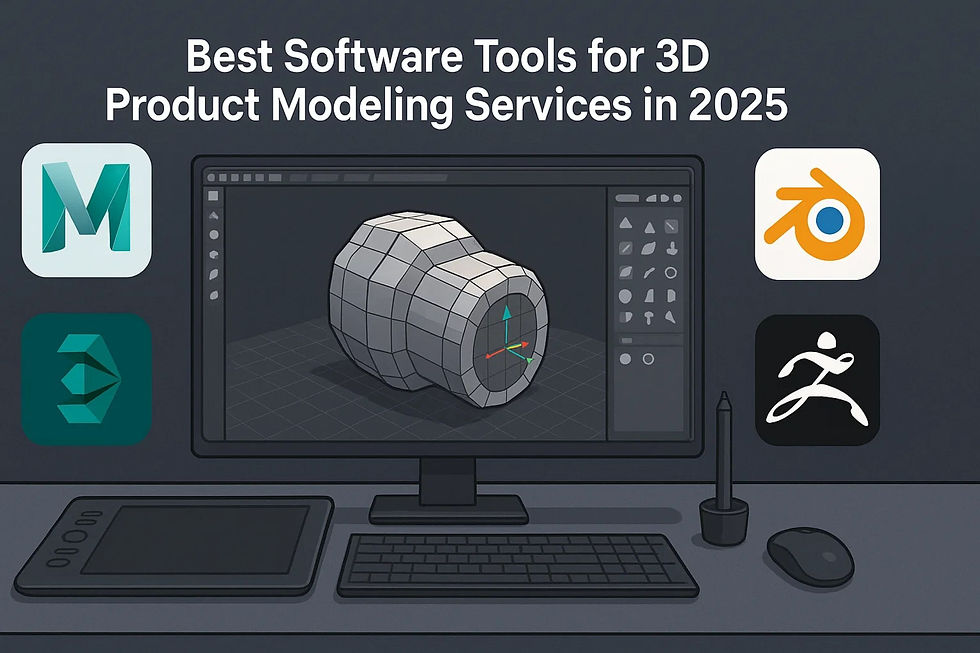The Use of AR 3D Modeling in Enhancing Online Shopping Experiences
- Hemant vizent
- Jul 24
- 5 min read

Know the Role of AR 3D Modeling in Enhancing Online Shopping Experiences
In the fiercely competitive landscape of e-commerce, merely displaying products with static images and text descriptions is no longer enough to capture consumer attention and drive conversions. Online shoppers crave immersive, interactive, and personalized experiences that bridge the gap between virtual Browse and the tangible reality of physical retail. This is where AR 3D Modeling steps in as a revolutionary force, transforming how consumers interact with products online and fundamentally enhancing the shopping journey. By bringing products to life in the customer's own environment, AR 3D Modeling is rapidly becoming an indispensable tool for businesses looking to gain a significant competitive edge.
Leveraging specialized 3D Product Modeling Services, companies can create highly accurate and optimized digital assets that power captivating AR Product Visualization experiences, allowing customers to virtually "try before they buy." This shift from passive viewing to active interaction is redefining the expectations of online retail, making the role of expert 3D Modeling Services more crucial than ever.
The Core Technology: AR 3D Modeling for Reality Integration
At its heart, AR 3D Modeling is the process of creating highly detailed, optimized three-dimensional digital representations of products specifically designed to be integrated into augmented reality experiences.
Real-world Overlay:
Unlike traditional 3D models viewed on a screen, AR 3D Modeling allows these digital products to be overlaid onto the user's live camera feed, making it appear as if the virtual item is physically present in their actual environment.
Scale and Proportion Accuracy:
A critical aspect of AR 3D Modeling is ensuring perfect scale. When a customer places a virtual sofa in their living room, it must appear at its true dimensions, allowing for precise fit assessment.
Texture and Material Realism:
For convincing AR Product Visualization, the AR 3D Modeling must accurately capture the nuances of materials, from the grain of wood and the weave of fabric to the sheen of metal or the subtle reflections on glass.
Interaction Capabilities:
The AR 3D Modeling needs to be structured to support user interactions, such as rotating the product, moving it around the space, or even changing colors and configurations, turning a static image into a dynamic 3D Model Augmented Reality.
Expert 3D Modeling Services specializing in AR 3D Modeling are crucial for achieving these technical and visual requirements.
Revolutionizing Customer Experience with AR Product Visualization
The tangible benefits of AR Product Visualization for online shoppers are profound, moving beyond mere viewing to immersive interaction.
"Try Before You Buy" Confidence:
This is the most significant advantage. Customers can virtually place furniture, appliances, or decor items in their homes to check size, style, and fit, significantly reducing purchase anxiety.
Personalized Context:
AR Product Visualization allows for an unprecedented level of personalization. Instead of imagining how a product might look, customers see it directly in their space, with their lighting, and alongside their existing decor.
Reduced Uncertainty & Returns:
By providing a clear understanding of product scale and appearance, AR Product Visualization minimizes the likelihood of customers ordering items that don't fit or don't match their expectations, directly impacting a retailer's bottom line by lowering return rates.
Enhanced Engagement & Exploration:
Customers spend more time interacting with AR-enabled products, exploring details, rotating items, and trying different variations.
Increased Conversion Rates:
The confidence and engagement fostered by AR Product Visualization directly translate into higher conversion rates, as customers are more likely to complete a purchase when they have a clear, realistic understanding of the product.
Choosing the Right 3D Product Modeling Services
To effectively implement AR into your online shopping platform, selecting the right 3D product modeling services provider is critical.
Specialization in AR:
3D Product Modeling Services serves the unique technical constraints and optimization requirements for mobile AR.
Optimization Expertise:
Ask do they understand polygon reduction, efficient UV mapping, and texture baking to ensure smooth performance on various devices for your 3D Model Augmented Reality?
Scalability and Workflow:
Can the 3D Product Modeling Services provider handle large volumes of products if needed?
Integration Support:
Can they provide the models in formats compatible with popular AR SDKs (e.g., Apple ARKit, Google ARCore, WebAR platforms)? This ensures seamless integration of the 3D Model Augmented Reality into your existing e-commerce infrastructure.
Versatility from Comprehensive 3D Modeling Services
While AR 3D Modeling is a key focus for online shopping, the underlying 3D Modeling Services can provide versatile assets for other applications, maximizing your investment.
VR 3D Modeling for Immersive Showrooms:
3D product modeling services provides an even deeper level of engagement for VR 3D Modeling.
Virtual Reality 3D Modeling for Training:
Manufacturers can use Virtual Reality 3D Modeling to create interactive training simulations for assembly, maintenance, or complex product operation, reducing the need for physical prototypes.
3D Modeling for 3D Printing and Prototyping:
The precision of the 3D models, especially from a skilled 3D Model Maker for 3D Printer, allows for rapid prototyping. Businesses can quickly 3D print physical prototypes for design validation or even produce customized products on demand, thanks to 3D Modeling for 3D Printing.
Product Configurators:
Enable customers to customize products in real-time, changing colors, materials, or adding features, all powered by the robust 3D Modeling Services.
The Future of Online Retail: A 3D Model Augmented Reality Revolution
Enhanced Personalization:
Future AR Product Visualization will likely integrate even more deeply with user data, suggesting products based on interior styles detected via AR, or offering real-time recommendations.
AR-Powered Product Discovery:
Cameras could identify real-world objects and suggest complementary products, all visualized through 3D Model Augmented Reality.
Ubiquitous Adoption:
As AR technology becomes more commonplace on mobile devices and potentially specialized AR glasses, AR Product Visualization will become an expected, rather than novel, feature of online shopping.
Conclusion
In the evolving world of e-commerce, 3D Model Maker for 3D Printer is no longer a luxury but a strategic necessity for businesses aiming to provide a superior online shopping experience. The expertise of 3D Product Modeling Services in creating optimized, high-fidelity 3D Model Augmented Reality assets is paramount to success. As the digital and physical worlds continue to converge, leveraging comprehensive 3D Modeling Services – from specialized AR 3D Modeling to versatile VR 3D Modeling and precise 3D Modeling for 3D Printing – will be the key for online retailers to differentiate themselves, captivate consumers, and lead the next wave of e-commerce innovation.





Comments